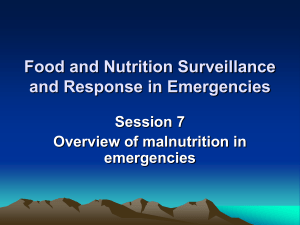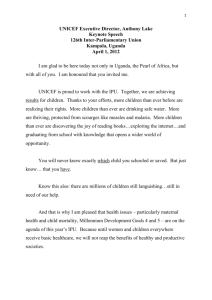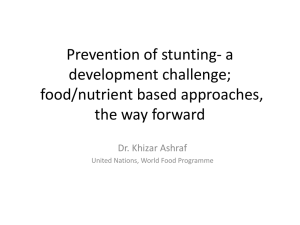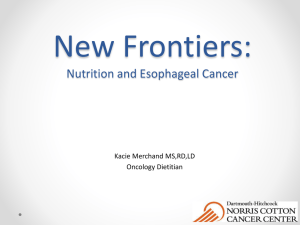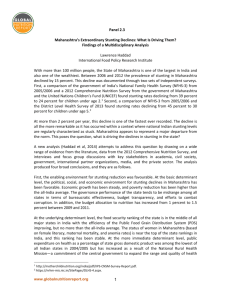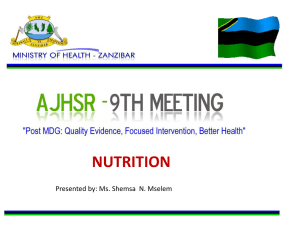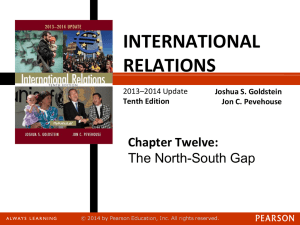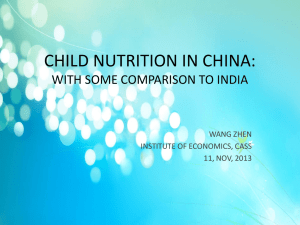Basic concepts on malnutrition_Unicef
advertisement
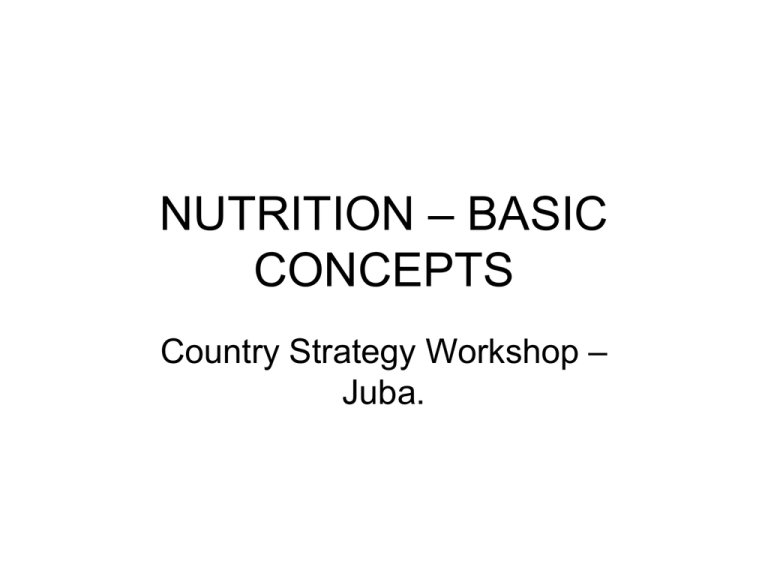
NUTRITION – BASIC CONCEPTS Country Strategy Workshop – Juba. Presentation Overview • Malnutrition: simple definition • Different forms of under-nutrition –Chronic under-nutrition (stunting) –Acute under-nutrition –Underweight –‘Hidden Hunger’ (micronutrient deficiency) • Causes of malnutrition: Food and Nutrition Security Conceptual Framework Malnutrition is … • “…A broad term for a range of conditions that hinder good health, caused by inadequate or unbalanced food intake or from poor absorption of food consumed. • It refers to both under-nutrition (food deprivation) and over-nutrition (excessive food intake in relation to energy requirements). RISKS of being undernourished Lowered resistance to disease Poor pregnancy/lactation Increased risk of mortality Reduced ability for physical activity Learning difficulties Chronic under-nutrition Chronic under-nutrition (stunting) is a result of persistent and cumulative effects of inadequate nutritional intake and frequent infections Influenced by maternal nutritional status preconception and during pregnancy Most evident between 6 – 12 months of age Shows no more improvement or worsening after 24 months Results in individuals short for their age and suboptimal function later in life Acute under-nutrition Acute under-nutrition (wasting) is a result of a severe and often sudden lack of food or illness. Can occur at any stage of the life-cycle but more common in infants & younger children. Easily reversible by correction of the food deficit or treatment of illness Characterised by thinness and/or the severe clinical form of oedema Acute under-nutrition: Oedema Underweight Underweight reflects both wasting and stunting Used to monitor/assess child growth in primary health care systems Used to evaluate country progress against the Millennium Development Goal (MDG) 1 i.e. “Eradicate extreme poverty and hunger.” Characterised by deficits in weight compared to an individual’s age Stunting Stunting Wasting Normal Stunting ‘Hidden Hunger’ (micronutrient deficiency) ‘Hidden hunger’ (micronutrient deficiency) occurs when people lack one or more essential micronutrients (vitamins & minerals), even if they consume adequate amounts of energy and protein. Deficiency starts “sub-clinically”, before visual presentation: hence ‘hidden’ Iron, Vitamin A, Iodine and (more recently) Zinc deficiencies are of global public health significance Vitamin C, B3 and B1 deficiencies are associated with populations suffering reduced access to a varied diet e.g. IDPs, refugees, etc.. Classification for assessing Severity of Malnutrition by prevalence ranges among Children under 5 years Indicator Severity of Malnutrition by Severity ranges (%) Low Medium High Very High Stunting <20 20-29 30-39 >=40 Underweight <10 10-19 20-29 >=30 Wasting <5 5-9 10-14 >=15 Source: WHO •Simply a starting point for interpretation •Crucial to put results in context of nutritional risks at time of assessment and analyse trends, seasonality, “usually observed” rates, etc.. CAUSES OF MALNUTRITION Food and Nutrition Security Conceptual Framework EXPOSURE TO SHOCKS AND HAZARDS Nutrition Status/ Mortality Individual Food Intake Individual level Health Status/ Disease HH level Context Household access To Food Social and Care Environment Access to Health Care & Health Environment Livelihood Outcomes Food Availability/ Markets Political, Economical, Institutional, Security, Social, Cultural, Gender, Environment Agro-ecological Conditions/ Climate (change) Livelihood Strategies HH Food Production, Income Generating Activities, Exchange, Loans, Savings, Transfers Natural Physical Human Economic Social Capital/Assets Community HH level Adapted from UNICEF (1990) Livelihood Assets
